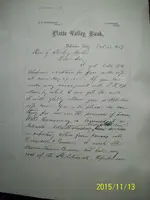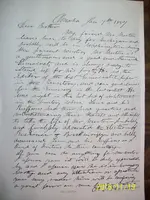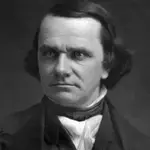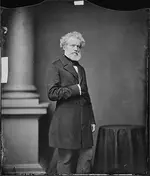Bibliography on "Bleeding Kansas"
Image of and link to sheet music "Ho! for the Kansas Plains," a song about making Kansas a free stateBelow are listed published materials in our collections related to territorial Kansas, 1854-1861, and the struggle between free-state and pro-slave forces.
Berneking, Carolyn, ed. "A Look at Early Lawrence: Letters From Robert Gaston Elliot." Kansas Historical Quarterly 43 (Autumn 1977): 282-296. Founder of Kansas Free State newspaper (1854) wrote to his sister and fiance, 1857-1866.
Cecil-Fronsman, Bill. "'Death to all Yankees and Traitors in Kansas': The Squatter Sovereign and the Defense of Slavery in Kansas." Kansas History 16 (Spring 1993): 22-33. Subsidized by the town company and edited by Kelley and Stringfellow, Atchison's pro-slave newspaper moderated its tone once the political battle was lost and became Freedom's Champion when John A. Martin took it over in 1858.
Connelley, William E. James Henry Lane: "The Grim Chieftain" of Kansas. Topeka, Kans.: Crane, 1899.
Cory, C. E. "Slavery in Kansas." Kansas Historical Collections 7 (1901-1902): 229-242. Discusses legal status of slavery and provides accounts of individual slaves.
Craik, Elmer LeRoy. "Southern Interest in Territorial Kansas, 1854-1858." Kansas Historical Collections 15 (1919-1922): 334-450. His 1922 University of Kansas doctoral dissertation.
Crafton, Allen. Free State Fortress: The First Ten Years of the History of Lawrence, Kansas. Lawrence, Kans.: World Co., 1954.
Farley, Alan W. "Annals of Quindaro: A Kansas Ghost Town." Kansas Historical Quarterly 22 (Winter 1956): 305-320. Quindaro was established in Wyandotte County, early 1856, as "a friendly portal for antislavery partisans to enter and leave Kansas."
Fellman, Michael. "Julia Louisa Lovejoy Goes West." Western Humanities Review 31 (Summer 1977): 227-242. Examines the "range and depth of Julia's experiences" in Kansas Territory; she was a New England emigrant dedicated to abolitionism who corresponded regularly with several Eastern newspapers.
Image of and link to an editorial cartoon, "Liberty, the Fair Maid of Kansas, in the hands of the Border Ruffians"__________. "Rehearsal for the Civil War: Antislavery and Proslavery at the Fighting Point in Kansas, 1854-1856." In Antislavery Reconsidered: New Perspectives on the Abolitionists. Lewis Perry and Michael Fellman, eds. (Baton Rouge: Louisiana State University Press, 1979), 287-307.
Gaeddert, G. Raymond. The Birth of Kansas. Lawrence: University of Kansas Publications, 1940. Detailed and reliable account of political events leading to Kansas statehood; emphasis on Wyandotte convention of 1859.
Gower, Calvin W. "Kansas Territory and Its Boundary Question: 'Big Kansas' or 'Little Kansas'." Kansas Historical Quarterly 33 (Spring 1967): 1-12. Pros and cons regarding this issue; former would have extended western border to Continental Divide and northern to Platte River.
Hart, Charles. "The Natural Limits of Slavery Expansion: Kansas-Nebraska Act, 1854." Kansas Historical Quarterly 34 (Spring 1968): 32-50. Age-old historical issue regarding survivability of the "peculiar institution" in these western territories.
Hougen, Harvey R. "The Marais des Cygnes Massacre and the Execution of William Griffith." Kansas History 8 (Summer 1985): 74-94. Provides details of the massacre on May 19, 1858, William Griffith's subsequent arrest, murder trial, conviction, and execution on Oct. 30, 1863.
Hurt, R. Douglas. Agriculture and Slavery in Missouri's Little Dixie. Columbia: University of Missouri Press, 1992. Chapters 10 and 11 give Missouri's side of the Kansas territorial problems.
Johannsen, Robert W. "The Lecompton Constitutional Convention: An Analysis of its Membership." Kansas Historical Quarterly 23 (Autumn 1957): 225-243. Pro-slave gathering of 1857 that sparked major national debate.
Image of advertisement of an anti-slavery meeting to be held on December 2, 1859, in Lawrence, on the day that abolitionist John Brown was executed, November 26, 1859Johnson, David W. "Freesoilers for God: Kansas Newspaper Editors and the Antislavery Crusade." Kansas History 2 (Summer 1979): 74-85. Picks half a dozen free state advocates in territorial Kansas, including John Speer and T. Dwight Thacher.
Johnson, Samuel A. "The Emigrant Aid Company in Kansas." Kansas Historical Quarterly 1 (November 1932): 429-441. Company's role in making Kansas free; concludes that it was of great importance, if not deciding factor, in struggle.
__________. "The Emigrant Aid Company in the Kansas Conflict." Kansas Historical Quarterly 6 (February 1937): 21-33.
__________. The Battle Cry of Freedom: The New England Emigrant Aid Company in the Kansas Crusade. Lawrence: University of Kansas Press, 1954.
Lovejoy, Julia Louisa. "'Letters From Kanzas.'" Kansas Historical Quarterly 11 (February 1942): 29-44. Letters begin with the planning of the journey west; originally published in Independent Democrat, Concord, N.H., in 1855.
Malin, James C. John Brown and the Legend of Fifty-Six. Philadelphia: The American Philosophical Society, 1942.
Mudge, Melville R., ed. "Benjamin Franklin Mudge: A Letter From Quindaro." Kansas History 13 (Winter 1990/1991): 218-222. Mudge's letter to his brother dated February 22, 1862, gives considerable attention to the movement of contrabands across the border.
Mullis, Tony R. "John Geary, Kansas, and the 1856 National Election." Heritage of the Great Plains 25 (Winter 1992): 13-24. Governor Geary's timely "quelling of violence in `Bleeding Kansas'," although only a temporary pacification, "virtually assured James Buchanan and the Democratic Party success in November."
Napier, Rita. "Economic Democracy in Kansas: Speculation and Townsite Preemption in Kickapoo." Kansas Historical Quarterly 40 (Autumn 1974): 349-369. Established by Weston, Missouri, developers on Kansas side of river in 1854, Kickapoo was one of many towns to vie for role as commercial center.
Image of title page of a publication by Charles W. Briggs called The Reign Of Terror In Kanzas, 1856Nichols, Alice. Bleeding Kansas. New York: Oxford University Press, 1954. A standard account of the conflict in the territory though rather dated in its interpretations.
Oates, Stephen B. To Purge This Land With Blood: A Biography of John Brown. New York: Harper and Row, 1970.
__________. "To Wash This Land in Blood: John Brown in Kansas." The American West. 6 (July and November 1969): 4:36-41; 6:24-27.
Pierson, Michael D., ed. "'A War of Extermination': A Newly Uncovered Letter by Julia Louisa Lovejoy, 1856." Kansas History 16 (Summer 1993): 120-123.
Potter, David M., and Don E. Fehrenbacher. "The Impending Crisis:" 1848-1861. New York: Harper & Row, 1976. This volume was edited and completed by Fehrenbacher.
Potts, James B. "North of `Bleeding Kansas': The 1850s Political Crisis in Nebraska Territory." Nebraska History 73 (Fall 1992): 110-118. Frequent mention of the Kansas struggle--a sharp contrast to Nebraska scene--and discussion of issues such as the annexation of the "South Platte" region to Kansas.
Rawley, James. Race and Politics: "Bleeding Kansas" and the Coming of the Civil War. Philadelphia: J. B. Lippincott Co., 1969. Argues that America was land of "racialists" and thus race, not slavery, was fundamental issue to be settled in Kansas Territory.
Robinson, Charles. The Kansas Conflict. 1892. Reprint. Lawrence, Kans.: Journal Publishing Co., 1898.
Robinson, Sara T.D. Kansas: Its Exterior and Interior Life: Including a full view of its Settlement, Political History, Social life, Climate, Soil, Production, Scenery, etc. 1856. Reprint. Lawrence: Kansas Heritage Press, 1990. Although its biases are obvious, this is an interesting and useful account by the wife of Dr. Charles Robinson, free-state leader and first state governor.
SenGupta, Gunja. For God and Mammon: Evangelicals and Entrepreneurs, Masters and Slaves in Territorial Kansas, 1854-1860. Athens, Ga.: University of Georgia Press, 1996. An intriguing examination of the complexity of free-state movement in Kansas Territory as well as the ideology and dynamics of proslavery activism.
__________. "'A Model New England State': Northeastern Antislavery in Territorial Kansas, 1854-1860." Civil War History 39 (March 1993): 31-46. New England abolitionists sought more than the defeat of slavery; they wished to place their "uniquely northeastern tapestry of `Americanism' over the morally and economically vulnerable West."
__________. "Servants for Freedom: Christian Abolitionists in Territorial Kansas, 1854-1858." Kansas History 16 (Autumn 1993): 200-213. Focuses on the beliefs and work of a handful of "radical" abolitionist missionaries affiliated with the American Missionary Association.
Sheridan, Richard B. "From Slavery in Missouri to Freedom in Kansas: The Influx of Black Fugitives and Contrabands Into Kansas, 1854-1865." Kansas History 12 (Spring 1989): 28-47.
Shortridge, James R. "People of the New Frontier: Kansas Population Origins, 1865." Kansas History 14 (Autumn 1991): 162-185. The author, a geographer, analyses the cultural influences wrought by settlers from four basic sub-regions east of the Mississippi.
Image of a drawing of Territorial Governor Andrew Reeder escaping Kansas Territory disguised as a wood chopper.Stampp, Kenneth M. America in 1857: A Nation on the Brink. New York: Oxford University Press, 1990. Considerable attention given to Lecompton movement and its nationwide influence.
Turk, Eleanor L. "The Germans of Atchison, 1854-1859: Development of an Ethnic Community." Kansas History 2 (Autumn 1979): 146-156. An early sizeable ethnic community.
U.S. Congress, House of Representatives. Report of the Special Committee Appointed to Investigate the Troubles in Kansas; With the Views of the Minority of Said Committee. Report No. 200, 34th Congress, 1st Session, 1856. An elaborate report, giving majority and minority views. Congressional publications, including the Globe, are replete with items pertaining to the Kansas question during the 1850s.
Veale, George W. "Coming In and Going Out." Kansas Historical Collections 11 (1909-1910): 5-12. Author's KSHS presidential address which was reminiscence of his early experiences, especially in 1850s Quindaro.
Watts, Dale. "How Bloody was Bleeding Kansas? Political Killings in Kansas Territory, 1854-1861." Kansas History 18 (Summer 1995): 116-129. After carefully analyzing the evidence, concludes that political killings number about fifty, far less than many have indicated, and that the violence was perpetrated about equally by both sides--free state and proslave.
Wilson, Paul E. "How the Law Came to Kansas." Kansas History 15 (Spring 1992): 18-35. Emphasis on the territorial period; an abbreviated version of this paper was published in the Journal of the Kansas Bar Association 63 (January 1994): 26-31.
Wolff, Gerald W. The Kansas-Nebraska Bill: Party, Section, and the Coming of the Civil War. New York: Revisionist Press, 1977. Based on his doctoral dissertation at the University of Iowa in 1969.










